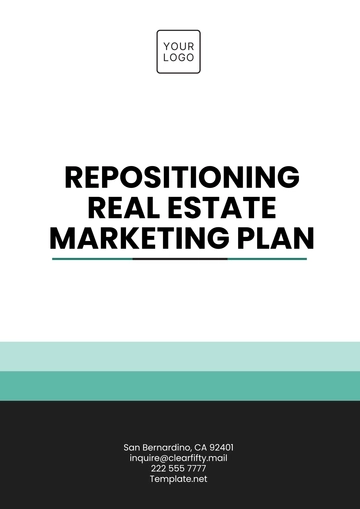Free Commercial Real Estate Property Marketing Plan

Prepared by:
[YOUR NAME]
[YOUR COMPANY NAME]
Executive Summary
This marketing plan outlines a strategic and comprehensive approach to effectively market our commercial real estate property. The goal is to leverage targeted marketing strategies and professional execution to attract high-quality tenants and investors while maximizing the property's value. By enhancing brand visibility, generating qualified leads, and achieving optimal occupancy rates, we aim to establish our property as a sought-after location for businesses in key sectors.
Market Analysis
Industry Overview
The commercial real estate sector is undergoing dynamic growth, driven by increasing urbanization, economic development, and an ongoing demand for prime locations, particularly in high-traffic urban centers. With the rise of remote work and hybrid business models, demand for flexible and modern office spaces has surged, creating a favorable environment for strategic marketing efforts.
Target Market
Our target market includes small to medium-sized businesses, startups, technology companies, retail chains, and service-oriented enterprises. These companies are looking for well-located spaces that offer modern amenities, flexible lease terms, and a professional environment conducive to growth and innovation. The demographic profile of our target market includes entrepreneurs, business owners, executives, and corporate decision-makers, predominantly in the tech, service, and retail sectors.
Key Segments
Small to Medium Enterprises (SMEs): Focused on businesses in their growth stages, seeking flexible lease terms and prime locations.
Tech Startups: Companies that value modern, adaptable spaces for innovation and collaboration.
Retail Chains and Franchises: Brands looking to expand their presence in high-traffic locations.
Corporate Clients: Established businesses seeking prime office space for administrative and executive operations.
Competitive Analysis
A thorough analysis of the competitive landscape within a 5-mile radius reveals several key competitors, each offering similar types of commercial spaces. However, our property stands out for its prime location, modern amenities, and flexible leasing options. Competitors generally offer less competitive terms, higher costs, or limited amenities, positioning our property as a superior choice for businesses looking for convenience, cost-efficiency, and flexibility.
SWOT Analysis:
Strengths: Prime location, modern amenities, competitive lease terms, strong local reputation.
Weaknesses: Higher initial marketing investment, new entrants in a competitive market.
Opportunities: Growing demand for flexible spaces, opportunity to attract tech and retail tenants.
Threats: Economic downturns, new competitor developments in the area.
Marketing Objectives
Increase Brand Awareness: Position our property as the premier choice for commercial real estate in the area.
Generate Qualified Leads: Implement targeted campaigns that produce qualified leads, aiming for a 25% increase in inquiries within the first 6 months.
Achieve a 90% Occupancy Rate: Attain a 90% occupancy rate within the first 12 months by attracting quality tenants through strategic marketing initiatives.
Marketing Strategies
Digital Marketing
A robust online presence is essential for attracting potential clients. We will utilize multiple channels, including:
Property Listing Platforms: List on prominent commercial real estate platforms like LoopNet, Zillow Commercial, and CoStar.
Social Media: Active presence on LinkedIn, Facebook, and Instagram to showcase the property’s features and reach a broad audience.
SEO and PPC Campaigns: Focused SEO strategies to rank for key search terms like "commercial real estate for lease," "office space in [City Name]," and targeted PPC campaigns designed to capture qualified traffic from local businesses.
Content Marketing
Create engaging and informative content to highlight the property’s advantages:
Virtual Tours and Webinars: Virtual property tours and webinars to engage remote tenants and offer detailed insights into the property.
Blog and Case Studies: Develop blog posts, tenant success stories, and case studies highlighting the benefits of leasing our property.
Email Marketing: Use targeted email campaigns to nurture leads, offering them information about availability, pricing, and incentives.
Local Engagement
Build relationships within the local community to enhance visibility:
Partnerships with Local Businesses: Collaborate with local service providers and businesses to cross-promote and expand our network.
Community Events and Open Houses: Host regular open house events for brokers and potential tenants, creating opportunities for direct engagement and relationship-building.
Sales Strategy
Equip our sales team with the knowledge and tools needed to convert leads into long-term tenants:
Sales Training: Provide in-depth training focused on the property’s unique selling points, leasing benefits, and how to address client objections effectively.
CRM Integration: Implement a Customer Relationship Management system to track leads, manage follow-ups, and ensure timely communication.
Lead Nurturing: Focus on building long-term relationships with potential tenants, maintaining contact even after the initial leasing process to ensure satisfaction and retention.
Budget Allocation
A clear and detailed breakdown of the marketing budget:
Category | Budget |
|---|---|
Digital Marketing | $50,000 |
Content Creation | $20,000 |
Local Engagement | $15,000 |
Sales Training | $10,000 |
Miscellaneous Expenses | $5,000 |
Total Budget: $100,000
Performance Metrics
We will measure the success of our marketing plan using the following metrics:
Qualified Leads: Track the number of leads generated through digital marketing channels and local events.
Occupancy Rate: Monitor occupancy progress with a goal of 90% occupancy within 12 months.
Return on Investment (ROI): Calculate ROI by comparing the marketing expenditure against the revenue generated from new tenants.
Engagement Metrics: Measure engagement levels through website traffic, social media interactions, and email open/click-through rates.
Tenant Retention: Monitor tenant retention rates post-lease and implement strategies for lease renewals.
Conclusion
This comprehensive marketing plan provides a clear and actionable roadmap for marketing our commercial real estate property. By focusing on targeted digital marketing, engaging content creation, and local community involvement, we aim to increase visibility, attract qualified tenants, and maximize the property’s occupancy. With a strong sales strategy, clear performance metrics, and budget allocation, we are positioned to achieve our marketing objectives and ensure long-term success.
- 100% Customizable, free editor
- Access 1 Million+ Templates, photo’s & graphics
- Download or share as a template
- Click and replace photos, graphics, text, backgrounds
- Resize, crop, AI write & more
- Access advanced editor
The Commercial Real Estate Property Marketing Plan Template from Template.net is an editable and customizable solution for promoting commercial properties. Tailor the plan to fit your marketing objectives with ease. Editable in our Ai Editor Tool, this template allows seamless adjustments, helping you craft professional strategies to effectively market commercial real estate.





























